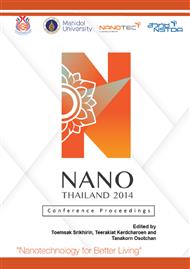[1]
J. Homola, Present and future of surface plasmon resonance biosensors, Anal. Bioanal. Chem. 377 (2000) 528-539.
Google Scholar
[2]
D.R. Shankaran, K.V. Gobi, N. Miura, Recent advancements in surface plasmon resonance immunosensors for detection of small molecules of biomedical, food and environmental interest, Sens. Actuators B 121 (2007) 158-177.
DOI: 10.1016/j.snb.2006.09.014
Google Scholar
[3]
C. Suti, M.H. Mooney, C.T. Elliott, J. Buijs, Advances in surface plasmon resonance biosensor technology towards high-throughput, food-safety analysis, TrAC Trends Anal. Chem. 29 (2010) 1305-1315.
DOI: 10.1016/j.trac.2010.09.003
Google Scholar
[4]
A.D. Taylor, J. Ladd, J. Homola, S. Jiang, Surface plasmon resonance (SPR) sensors for the detection of bacterial pathogens, in: M. Zourob, S. Elwary, A. Turner (Eds. ), Principles of Bacterial Detection: Biosensors, Recognition Receptors and Microsystems. Springer Science+Business Media, LLC, New York, pp.91-92.
DOI: 10.1007/978-0-387-75113-9_5
Google Scholar
[5]
C. Puttharugsa, T. Wangkam, N. Huangkamhang, O. Gajananda, O. Himananto, B. Sutapun, R. Amarit, A. Somboonkaew, T. Srikhirin, evelopment of surface plasmon resonance imaging for detection of Acidovorax avenae subsp. citrulli (Aac) using specific monoclonal antibody Biosens. Bioelectron. 26 (2011).
DOI: 10.1016/j.bios.2010.10.007
Google Scholar
[6]
P. Leonard, S. Hearty, J. Quinn, R. O'Kennedy, A generic approach for the detection of whole Listeria monocytogenescells in contaminated samples using surface plasmon resonance, Biosens. Bioelectron. 19 (2004) 1331–1335.
DOI: 10.1016/j.bios.2003.11.009
Google Scholar
[7]
A.D. Taylor, Q.M. Yu, S.F. Chen, J. Homola, Y. Jiang, Comparison of E-coli O157: H7 preparation methods used for detection with surface plasmon resonance sensor, Sens. Actuators B 107 (2005) 202–208.
DOI: 10.1016/j.snb.2004.11.097
Google Scholar
[8]
E. Hutter, S. Cha, J.F. Lui, J. Park, J.H. Yi, D. Roy, Role of substrate metal in gold nanoparticle enhanced surface plasmon resonance imaging, J. Phys. Chem. B 105 (2001) 8-12.
DOI: 10.1021/jp003565q
Google Scholar
[9]
D.L. Hopkins, C.M. Thompson, J. Hilgren, B. Lovic, Wet seed treatment with peroxyacetic acid for the control of bacterial fruit blotch and other seedborne diseases of watermelon, Plant Dis. 87 (2003) 1495-1499.
DOI: 10.1094/pdis.2003.87.12.1495
Google Scholar
[10]
O. Himananto, P. Thummabenjapone, P. Luxananil, M. Kumpoosiri, R. Hongprayoon, W. Kositratana, O. Gajanandana, Novel and highly specific monoclonal antibody to Acidovorax citrulli and development of ELISA-based detection in cucurbit leaves and seed, 95 (2011).
DOI: 10.1094/pdis-12-10-0889
Google Scholar
[11]
J. Turkevich, P.C. Stevenson, J. Hiller, Preparation of 2. 5×10-4 M gold colloids (sodium citrate reduction method), 1951. Discuss. Faraday Soc. 11 (1951) 55-59.
Google Scholar
[12]
W. Haiss, N.T.K. Thanh, J. Aveyard, D.G. Fernig, Determination of size and concentration of gold nanoparticles from UV−Vis spectra, Anal. Chem. 79 (2010) 4215-4221.
DOI: 10.1021/ac0702084
Google Scholar
[13]
F. Li, Q. Zhao, C. Wang, X. Lu, X.F. Li, X.C. Le, Detection of Escherichia coli O157: H7 using gold nanoparticle labeling and inductively coupled plasma mass spectrometry, Anal. Chem. 82 (2010) 3399-3403.
DOI: 10.1021/ac100325f
Google Scholar
[14]
N. Houngkamhang, A. Vongsakulyanon, P. Peungthum, K. Sudprasert, P. Kitpoka, M. Kunakorn, B. Sutapun, R. Amarit, A. Somboonkaew, T. Srikhirin, ABO blood-typing using an antibody array technique based on surface plasmon resonance imaging, Sensors 13 (2013).
DOI: 10.3390/s130911913
Google Scholar


